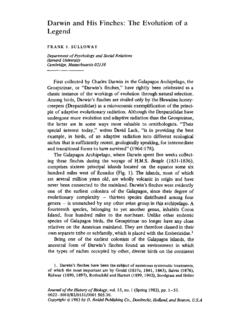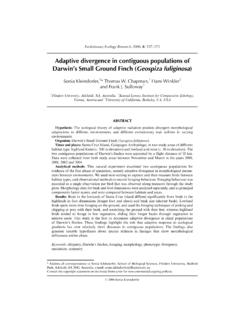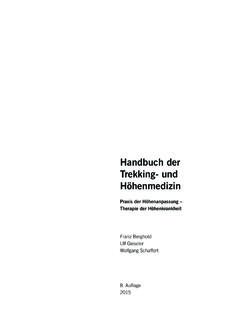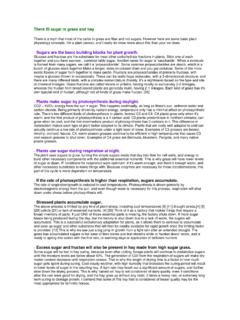Transcription of BIRTH ORDER, SIBLING COMPETITION, AND …
1 39 BIRTH order AND SIBLING COMPETITIONCHAPTER 2 BIRTH order , SIBLING COMPETITION, and human BEHAVIORFRANK J. SULLOWAYU niversity of California, BerkeleyAbstract: SIBLING competition is widespread among bird and animalspecies and sometimes leads to siblicide. By influencing the strategiesthat siblings employ in their struggles for dominance, BIRTH order af-fects the outcomes of such contests. In our own species, BIRTH order isa proxy for disparities in age, physical size, and status, all of whichcontribute to personality. In addition, BIRTH order is related to the rolesand niches available to offspring within the family system. On aver-age, firstborns who tend to act as surrogate parents are more con-scientious than laterborns, whereas laterborns are more agreeable,extraverted, and nonconforming.
2 As strategies for dealing with rivalsin a dominance hierarchy, as well as for optimizing parental invest-ment, these SIBLING differences are consistent with a Darwinian per-spective on family life. So are other links between personality andfamily dynamics, particularly those associated with parental invest-ment and parent-offspring conflict. In adulthood, human behavior con-tinues to reflect these formative influences, although such behavioraldispositions generally need to be catalyzed by appropriate situations inorder to be fully THE BIOLOGY OF SIBLING COMPETITIONA wide variety of animal species exhibit BIRTH - order differences inbehavior, usually in competition for parental investment. These be-havioral effects are influenced by two distinct kinds of biological causes:ultimate and proximate.
3 Ultimate causes include adaptive tendenciesthat have evolved by natural selection. Proximate causes compriseinfluences operating during the lifetime of the organism and encom-39 SULLOWAY40pass biological as well as environmental factors, which almost alwaysinteract with one another. For example, some avian species possessan instinct to migrate during the autumn and spring, an adaptation thathas its ultimate cause in natural selection. Temperature and day length,along with the various neuropsychological mechanisms they trigger,supply the proximate causes of bird migration (Mayr, 1961).Viewed in these conceptual terms, a biological propensity to en-gage in SIBLING rivalry is one of the ultimate causes of personalitydevelopment.
4 Darwin s theory of natural selection explains this partof the story, which focuses on the biological dispositions that mostoffspring have to compete for parental favor. As William Hamilton(1964) recognized, natural selection maximizes inclusive fitness. Thisform of Darwinian fitness can be defined as an organism s ownreproductive success, together with its contribution to the reproduc-tive success of close relatives, discounted according to their coeffi-cient of relatedness. On average, siblings share half of their s theory asserts that siblings will compete for scarce re-sources whenever the benefits of doing so are greater than twicethe costs. competition for parental investment is the main cause ofsibling a Darwinian point of view, SIBLING competition and parent-offspring conflict are flip sides of the same coin.
5 Parents are equallyrelated to all of their offspring and generally favor equal sharing amongthem, whereas siblings usually prefer a bias in their own favor. Amonganimals, weaning conflicts are an example of such disagreements. Atthe time of weaning, offspring want parents to continue investing inthem, and them alone, whereas parents are inclined to reserve addi-tional investment for future offspring (Trivers, 1974).Darwinian and Freudian theory supply contrasting explanations forparent-offspring conflict, as Daly and Wilson (1990) have pointed Freudian theory, such conflicts have their origins in the child s de-sire for sexual access to the opposite-sex parent an urge that con-stitutes the Oedipus complex. In Darwinian theory, sexual desires havenothing to do with these conflicts.
6 Rather, siblings compete to opti-mize parental investment and hence to get out of childhood alive. Sib-lings may be inclined to harm their rivals for parental investment, butthey have no Darwinian incentive to harm a parent at least not forthe reasons Freud himself As Daly and Wilson have ar-gued, Freud systematically misinterpreted evidence for parent-off-spring conflict which is generally nonsexual in nature to fit histheoretical order AND SIBLING COMPETITIONS iblicideFatal SIBLING competition has been documented in insects, fish, andmammals. Even plants exhibit competition that sometimes ends insiblicide. The Indian black plum tree (Syzygium cuminii) developsseeds having 25 to 30 ovules all siblings.
7 Only one ovule survives tobecome the pit of the mature fruit usually the ovule that is fertilizedfirst. This first-fertilized seed secretes a death chemical that pre-vents its siblings from being able to metabolize sucrose, causing themto starve to death (Krishnamurthy, Shaanker, & Ganeshaiah, 1997).Among animals, SIBLING competition usually centers around paren-tal investment. Among sea birds and predatory birds, siblicide is par-ticularly common (Mock, Drummond, & Stinson, 1990; Mock & Parker,1998). In some species, such as African black eagles (Aquilaverreauxi), siblicide is obligate occurring in almost every female of this species lays two eggs, and the first-hatched chickpecks its younger SIBLING to death during the first days of life.
8 In onedocumented case, an elder chick delivered more than 1,500 pecks toits younger SIBLING during the latter s three-day lifespan. In all siblicidalspecies studied to date, report Mock et al., there is a striking ten-dency for the victim to be the youngest member of the brood (1990,p. 445). It is noteworthy that avian parents never intervene whenchicks are engaged in siblicidal aggression. The parents own geneticinterests are generally best served by raising one healthy chick ratherthan two undernourished blue-footed boobies (Sula nebouxii), females lay two oreven three eggs. Siblicide is conditional in this species, depending onthe food supply, which is therefore a proximate cause of pecking of a younger chick by an elder begins when theelder s body weight drops below 80 percent of normal.
9 In experimen-tal studies in which the necks of booby chicks have been taped toprevent them from ingesting food, aggression increases sharply and isespecially pronounced in the elder chick (Drummond & Garc a-Chavelas, 1989).Hatching order in boobies is associated with learned behaviors. Inone experimental study, junior chicks that had developed subordinatebehaviors were removed from their nests and paired with smallerdominants from another nest. Size normally decides dominance inboobies. In this experiment, however, smaller chicks that had previ-ously been seniors were successful in achieving dominance over largerbut previously junior chicks. The superiority of the smaller senior chicksSULLOWAY42owed itself to their refusal to submit when attacked, and by their gen-erally being more capable fighters than chicks that had previouslybeen subordinate (Drummond & Osorno, 1992).
10 Whether siblicide is conditional or unconditional is determined byvarious ecological considerations that have shaped the genetic predis-positions of each species. Blue-footed boobies do not have fixed ter-ritories, and, when the food supply is plentiful, they can generally rearmore than one chick in a year. By contrast, African black eaglesoccupy fixed territories and their young require unusually large amountsof food, circumstances that limit the parents ability to raise more thanone chick, even in a very good do avian parents regularly lay more eggs than are needed inany given breeding season? Two adaptive benefits are associated withthis practice. First, an additional chick represents an insurance policy,in case an older chick dies of disease or predation.








